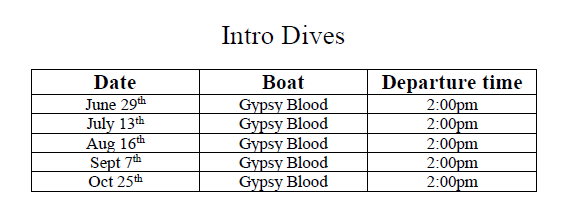Congratulations! You’re an Advanced Open Water diver who’s interested in experiencing local diving — aka Wreck Diving. Why not put your newly acquired skills to use on a local dive? Who knows, if you’re lucky enough, you might catch dinner! We also offer training in Wreck Diving if you want a more comprehensive experience.
Blue Water Divers offers you an opportunity to experience local diving with the benefit of an experienced local divemaster as your guide. While you’re still responsible to have all of the necessary equipment listed below on an Intro-to-Wreck dive, your divemaster will show you around the dive boat, give you a briefing about the protocol when on the dive boat, and help you get suited up and in the water.
Once you’re underwater, your divemaster will navigate around the wreck, point out things of interest like lobster, black fish and maybe even scallops and bring you back to the boat at the end of the dive.
When you first sign up, we’ll invite you in to the store where you will receive an Introduction to North East Wreck Diving Guide and a presentation on what to bring, where to meet, what time to be there and lots more.
Once you have been out on the Intro-to-Wreck dives, we also offer non-guided chartered dives once a month with the Gypsy Blood. See below for our Wreck Schedule and you can also visit this website, https://njscuba.net/, for a more in-depth look at the wrecks scattered along our shores.
Equipment Checklist
- Full 7mm wetsuit or drysuit
- Hood
- BCD
- Regulator with octopus and gauges
- Tank(s)
- Mask
- Snorkel
- Fins
- Booties
- Cold water gloves
- Weight belt with 10% of your body weight plus 5lbs
- Log Book
- C-card
- Dive Tables or Dive Computer
- Gear Bag
- Safety sausage and audible signaling device
- Knife or safety shears
- Independent redundant air supply (pony rig setup, doubles, etc) unless participating in an Intro Dive
Highly Recommended Equipment
- Dive Light with brass clip or lanyard
- Spare parts kit
- Slate and pencil
Seasickness
Be sure to take preventative measures for seasickness. It is reality and can ruin your day. Commonly available preventatives may be helpful.
Additional Recommendations
- Pack a lunch and plenty of water to drink. Use as small cooler as possible to save deck space on the boat.
- You may want to bring a small separate bag to store dry clothes, logbooks etc. Be sure to pack a warm jacket or sweatshirt as it can be very cool on the ocean in the early morning.
- Sun Block and Sun Glasses are also a good idea.
- It is advised that you mark your name on your equipment and use a gear bag to prevent loss or damage to your gear.
- Please arrive at least 30 minutes prior to departure time in order to put your equipment on board. Boats leave promptly as they are often scheduled with drawbridge opening on the hour.

Destinations are not guaranteed. All Depths are approximate.

